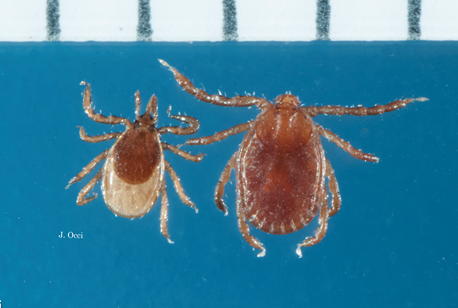
SHARE THIS ARTICLE:
Longhorned Ticks Survived the NJ Winter: Invasive Species May Be Established
 Nymphs scapularis on left, longicornis on right. Thanks to J. Occi, RutgersThe Lyme Disease Association reports that on April 17, 2018, a new tick species to the U.S. has been confirmed by the U.S. Department of Agriculture’s National Veterinary Services Laboratory (NVSL) to have wintered over in NJ, and it may now be an established species. Haemaphysalis longicornis, aka longhorned or bush tick, was confirmed in Hunterdon County, NJ, on November 9, 2017 and a mystery still surrounds its appearance. Initial ID was done by Rutgers University Center for Vector Biology and Hunterdon Co. Department of Health. The animals and property on which the ticks were found were treated to eliminate the tick last year, but the effort was apparently unsuccessful. Wildlife surveillance in the area is continuing to determine if the ticks have spread beyond that area. This tick from East Asia is a serious problem for livestock, particularly in New Zealand, as well as to pets and humans. The tick is dark brown and grows to pea size when fully engorged.
Nymphs scapularis on left, longicornis on right. Thanks to J. Occi, RutgersThe Lyme Disease Association reports that on April 17, 2018, a new tick species to the U.S. has been confirmed by the U.S. Department of Agriculture’s National Veterinary Services Laboratory (NVSL) to have wintered over in NJ, and it may now be an established species. Haemaphysalis longicornis, aka longhorned or bush tick, was confirmed in Hunterdon County, NJ, on November 9, 2017 and a mystery still surrounds its appearance. Initial ID was done by Rutgers University Center for Vector Biology and Hunterdon Co. Department of Health. The animals and property on which the ticks were found were treated to eliminate the tick last year, but the effort was apparently unsuccessful. Wildlife surveillance in the area is continuing to determine if the ticks have spread beyond that area. This tick from East Asia is a serious problem for livestock, particularly in New Zealand, as well as to pets and humans. The tick is dark brown and grows to pea size when fully engorged.
UPDATE: In addition to the Hunterdon County farm, the Longhorned tick has been confirmed in other parts of NJ: the Rutgers University–New Brunswick’s Cook Campus farm in Middlesex County, and the NVSL recently confirmed a tick taken from a dog in Union County in 2013 was also a Longhorned tick. June 5, 2018, NVSL confirmed the Longhorned tick was found at a location in northern Mercer County. July 21, Longhorned tick found in Bergen County)
According to James L. Occi, PhD (in progress), Center for Vector Biology, Department of Entomology, Rutgers, also a Scientific Advisory Board Member for the Lyme Disease Association, Inc., dragging for the ticks was not successful so they used CO2 traps to lure the ticks. Problematic is that “the scientists with the most experience with this tick are in parts of Asia, Australia, and New Zealand.”
In other parts of the world, this tick has been associated with several human diseases including spotted fever rickettsiosis. The NJ Department of Agriculture indicates it has had the ticks tested, and so far, the tests have not shown any tick-borne diseases. The tick in Asia is known to reproduce by parthenogenetic reproduction, meaning the tick can come from an unfertilized egg. Nymphs of the longhorned tick are small like the nymph of the deer tick.
Click here for NJ Department of Agriculture Press Release
Click here for 2017 Report Identifying Longhorned Tick in NJ
Longhorned Tick in NJ:
7/21/18 northjersey.com Exotic Longhorned tick found in Bergen County
6/5/18 mycentraljersey.com Longhorned tick spreads to Mercer County
5/10/18 NBC, NY Longhorned Tick Mysteriously Invades New Jersey, Has Already Spread
5/7/18 mnn.com This Self-cloning Tick Now Calls N.J. Home: Longhorned Tick Survived the Winter and is Poised to Spread
4/21/18 LDA website Longhorned Ticks Survived the NJ Winter: Invasive Species May Be Established
Longhorned Tick Spreading to Other States – Click here





